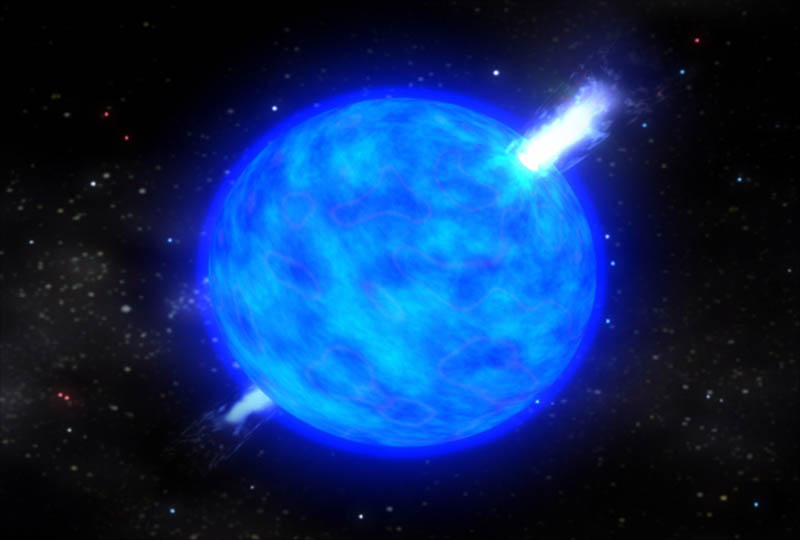Welcome to GRBs on STARKFX.com!
This is one of the darkest articles you'll ever see on STARKFX.com and it is about one of the brightest events in the universe, a million trillion times brighter than the Sun. In this article I'll tell you about a threat that could wipe out life on earth, and may have indeed done so before. This threat is unstoppable, gives no warning and may be inevitable. As a matter of fact, Dec 21, 2012 is just as likely a time for the next big life-ending gamma ray burst as any other time. What I'm talking about is a gamma ray burst originating in our galaxy. Such a burst would be close enough to destroy our atmosphere and all living creatures. So, if you can handle it, read on and find out just how precarious life really is.
Gamma Ray Bursts
Gamma ray bursts, GRBs, are short lived bursts of highly energetic photons. These photons have extremely short wavelenghts and, on the electromagnetic spectrum (E/M radiation extends from radio waves to X-rays and gamma rays) they make up everything with a wavelength shorter than X-Rays. These bursts originate outside our solar system, and most, if not all, originate outside our galaxy.
Origins
Events capable of creating gamma ray bursts would be extreme, dramatic events such as supernovae or even hypernovae. These are the catastrophic ends to super-massive stars.
Although no two GRBs are the same, they are divided into two classes: Long duration and short duration GRBs. Astronomers think that the two classes are created by fundamentally different kinds of events. As of now, there are only theories to explain the short GRBs so they remain quite a mystery, but the long durations GRBs, lasting more than 2 seconds, are better understood.
These long duration GRBs can originate from the farthest edges of the obserbable universe which means we are "seeing" these events billions of years after the fact. These stars are too distant to be observed in the visible or IR spectrum until the supernova or hypernova event makes them visible in the full spectrum including gamma rays. Using large amounts of data collected over the past 15 years with special instruments aboard satellites, such as NASA's Compton Gamma-Ray Observatory and the joint Italian-Dutch BeppoSAX, astronomers have learned a great deal about the stars that create these events. Dr. Stan Woosley of the University of California, Santa Cruz, one of the architects of the model that explains these bursts, called the model the "Collapsar" model. The full theory is known as the "collapsar/hypernova" model to keep in mind both the core collapse and the supernova explosion. This model involves the collapse of the core of a special kind of star called a "Wolf-Rayet" star after two 19th Century French astronomers, Charles Wolf and Georges Rayet, who studied the first example. These stars are very heavy, very hot, and prone to episodic fits in which large amounts of material are ejected from it. According to the theory, a black hole forms from the collapsing core of this massive star. The collapse causes a shockwave moving through the star at near the speed of light. When this shockwave encounters stellar material still deep in the star, gamma rays are produced which emerge from the surface of the star just ahead of the blast wave. As the blast wave erupts from the surface of the star it encounters more material outside the star and results in a cascading series of E/M emissions starting with X-rays, then visible, then IR and finally dying off in radio emissions. This "afterglow" phase can last for days or even weeks. We observe these events only when the earth is "favourably" aligned along the axis of the blast so that we see only a fraction of the number of such events out there.
Discovery
In the late 1960s US military satellites watching for Soviet nuclear tests in the atmosphere carried gamma ray detectors because nuclear explosions release gamma rays. Those instruments discovered short bursts of gamma rays originating from outside our solar system. Just how far away the sources were was not clear and even into the 1990s scientists were not certain whether these bursts originated just outside our solar system, from inside our galaxy or from the edges of the known universe. But now, many more satellite observations followed by ground-based observations, and theoretical work have allowed astronomers to link GRBs to supernovae in distant galaxies as described by the collapsar/hypernova model mentioned above.
Effects
What would be the effect of a gamma ray burst from within our galaxy? One scenario is proposed by Astrobiologist Adrian Melott from the University of Texas, paleontologist Bruce Lieberman from the University of Kansas and others, as the cause of the Ordovician extinction 440 million years ago.
Their description: "Around 440 million years ago, a supernova within 10,000 light years of Earth exploded in a gamma-ray burst. The radiation destroyed the composition of the Earthís atmosphere, ripping apart the nitrogen and oxygen molecules. The planet became enveloped in brown smog - made up of lethal nitrogen dioxide - which blocked out the Sunís heat. Though the gamma ray burst lasted just a few seconds, the resulting smog triggered an ice age." Most life exposed to the gamma ray burst would have been killed by that alone, and then the toxic smog, but it gets worse. The nitrogen dioxide cloud blocked the Sunís infrared rays, but it didnít obstruct the shorter wavelengths of the ultraviolet. This was doubly bad news for the Earth, because the gamma-rays had also produced nitrogen oxide which destroyed the ozone layer. As a result, our planetís surface had no protection from a 300% increase in UV radiation.
The Future
Some scientists are convinced that the earth has suffered destruction by gamma ray bursts more than once in its 4.5 billion year history. These same scientists believe that in can happen again, without any warning. We can't predict when they will happen, where they will come from and there is nothing we can do to prevent them! But then, this isn't really any different than everyday life on an individual basis is it?

References
Hooper Virtual Paleontological Museum - mass extinctions
http://park.org/Canada/Museum/extinction/tablecont.html
NASA - the low-down on gamma-ray bursts
http://imagine.gsfc.nasa.gov/docs/science/know_l1/bursts.html
http://www.firstscience.com/home/articles/space/gamma-ray-wipe-out-page-3-1_31878.html
Quick Science & Math References
- Our Solar System.
- Earth Facts.
- The Metric System.
- Trigonometric Identities.
- Vector & Tensor Identities.
- Explicit Forms of Vector Operators
- Light & Electromagnetic Spectrum.
- Common Laser Wavelengths.
- Human Physiology Facts.
- Human History Timeline
- Geologic Timeline
- Cambrian Explosion
- Life on Earth Timeline
- ASCII Codes and HTML Display Codes
- Thousands of HTML Symbol Codes
- HTML Symbol Codes for Greek Letters
- The Best Way to put Equations on your Web Page
Physics Basics Series
- Basics of Classical Mechanics.
- Basics of Quantum Mechanics.
- Basics of Electrodynamics.
- Basics of Optics.
- Basics of Mathematical Tools for Physics.
- Basics of Plasma Physics.
- Basics of Solid State Physics.
Math Basics Series
- Numbers
- Arithmetic
- Algebra
- Geometry
- Analysis
Technology Basics Series
- Basics of Remote Sensing.
- Basics of Digital Signal Processing.
- Critical Electronic Circuits
- Infrared Imaging Basics
Knowledge Branches
- Information Theory
- How Reading Works in the Brain
- Psychology of Learning
- Logic
WORK IN PROGRESS
- What is the Stark Effect?
- The Chemistry of Love &/or Addiction
- Critical Thinking: How to question what you see, read or hear.
- Aristotle's Prior Analytics - the birth of Logic.
- Optical Solutions, lenses that solve problems
- Fractals
- PTC - Photon Transfer Curve or Mean Variance Analysis
- 3-D Noise
- Laser Primer
- Rail Guns
- Special Relativity
- Radar Technology
- Acousto-optic Cells
- Harmonic Generation for Laser Frequency Doubling (SHG) and Tripling -using non-linear crystals.
- Measurement: Accuracy & Precision.
- Things you should know about computer modeling of physical phenomena!
- Giant Magneto-resistance
- Peltier Cooling
- Pyro-Electric Detectors
- Piezo-Electric Crystals
- Laser Speckle
- FFT and DFT the fast fourier transform and the discrete fourier transform
- Fabry Perot Etalon
- The Hydrogen Atom.
- PCA (Principal Component Analysis)
- Energy per mass in fuels such as Hydrogen, Gasoline, Kerosene, HMX etc...
- Nobel prize winning work on the CCD
- How does a CCD work and what are the normal characteristics of a CCD
- Nobel Prize Winning work on Giant Magneto-resistance
- FROG -frequency resolved optical gating
- Optical Wavefront Sensing
- THz imaging and time-domain spectroscopy
- Camera Calibration
- Laser Designators
- Resampling
